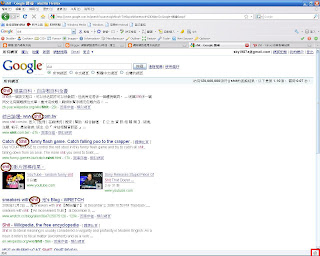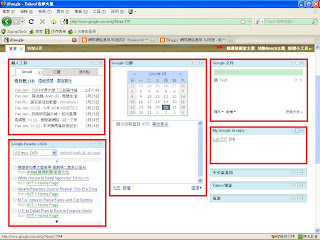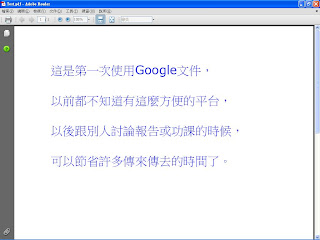2009年3月27日 星期五
Lab 15:Tongwen
Lab 14:Clean Language
1. Save the JavaScript file of Clean Language to your desktop. Make changes to the script with self-defined bad words. To do this, save the JavaScript on your desk top. Use Notepad editor to make changes. Install the modified script as Greasemonkey.

2. Use Google to search webpages that contains some bad words.
(1)開啟前:

(2)開啟後:

3. Try whether the filtering take effects.
2. Use Google to search webpages that contains some bad words.
(1)開啟前:
(2)開啟後:
3. Try whether the filtering take effects.
Lab 13:GreaseMonkey
1.Install Greasemonkey 0.8. Check the lower right corner of your Firefox and you should find a monkey at the right. Note that you must run the

2. Cookie Monster - Show cookie contents: Shows the contents of the current page cookie. Just mouse over the "Cookie" text on the bottom left. Check what cookies http://www.nytimes.com writes to you. Does our class blog use cookie or not? Does Google use cookie?
(1)http://www.nytimes.com:

(2)Class Blog:

(3)Google:

3. You can turn off Greasemonkey by clicking on the monkey face at the URL bar of Firefox. Click again to activate Greasemonkey.


4. Install Web Developer Toolbar to examine cookies.

2. Cookie Monster - Show cookie contents: Shows the contents of the current page cookie. Just mouse over the "Cookie" text on the bottom left. Check what cookies http://www.nytimes.com writes to you. Does our class blog use cookie or not? Does Google use cookie?
(1)http://www.nytimes.com:
(2)Class Blog:
(3)Google:
3. You can turn off Greasemonkey by clicking on the monkey face at the URL bar of Firefox. Click again to activate Greasemonkey.
4. Install Web Developer Toolbar to examine cookies.
2009年3月26日 星期四
Homework 3-20-2009
1. 網站提供 RSS 內容餵送(feed) 有何好處?
Ans:RSS最大的好處是快速,當我自己有興趣的Blog很多的時候,一個個Blog link過去瀏覽就變得很浪費時間,經由RSS,可以挑選自己有興趣的標題,再決定要不要閱讀詳細內容。現在資訊來源這麼多,一個個網站去逛便非常耗時,RSS提供了一個方式去決定我們要接受哪些資訊,要不要去看那些更詳細的內容,使我們可以選擇自己所需要的。
2. 比較個人化入口網,與常見商業入口網的差別。例如廣告,內容,應用,服務,個人化程度等等各方面的比較。
Ans:個人化入口網,能依照使用者自己的需求,去改變它的功能,比起商業入口網站更人性化,不會有多餘的廣告,一堆彈跳視窗,完全就是依照自己的需要,提供良好的服務。
3. 在Google 個人入口加入以下元件: GMail, Google Reader, Google Calendar, Google Docs, Google Groups.

Ans:RSS最大的好處是快速,當我自己有興趣的Blog很多的時候,一個個Blog link過去瀏覽就變得很浪費時間,經由RSS,可以挑選自己有興趣的標題,再決定要不要閱讀詳細內容。現在資訊來源這麼多,一個個網站去逛便非常耗時,RSS提供了一個方式去決定我們要接受哪些資訊,要不要去看那些更詳細的內容,使我們可以選擇自己所需要的。
2. 比較個人化入口網,與常見商業入口網的差別。例如廣告,內容,應用,服務,個人化程度等等各方面的比較。
Ans:個人化入口網,能依照使用者自己的需求,去改變它的功能,比起商業入口網站更人性化,不會有多餘的廣告,一堆彈跳視窗,完全就是依照自己的需要,提供良好的服務。
3. 在Google 個人入口加入以下元件: GMail, Google Reader, Google Calendar, Google Docs, Google Groups.
Lab 12:Online Editing
1. Go to Google Docs. Google Docs lets you write Word documents through an online web service.

2. Start writing.

3. Publish the Word document.

4. What's the URL of your document.
http://docs.google.com/Doc?id=dcqwgn6f_0cpzgq5kq
5. Add the Google Docs to your personal portal. At the portal page、you should be able to see the active documents.

6. Save your document as .doc and .pdf、the two common formats for documents.


2. Start writing.
3. Publish the Word document.
4. What's the URL of your document.
http://docs.google.com/Doc?id=dcqwgn6f_0cpzgq5kq
5. Add the Google Docs to your personal portal. At the portal page、you should be able to see the active documents.
6. Save your document as .doc and .pdf、the two common formats for documents.
2009年3月20日 星期五
Lab 11:Personal Portal
1. Enter
http://www.google.com/ig
The Google account is the same as your Blogger account.
2. Rearrange the templates. And perhaps remove blocks that you don't need.
3. Add new stuff. For now add the Google Reader, Google Docs, Google Group, Google Calendar, and GMail. You should be able to see the subscriptions in the Google Reader block of your personal portal.

http://www.google.com/ig
The Google account is the same as your Blogger account.
2. Rearrange the templates. And perhaps remove blocks that you don't need.
3. Add new stuff. For now add the Google Reader, Google Docs, Google Group, Google Calendar, and GMail. You should be able to see the subscriptions in the Google Reader block of your personal portal.
Lab 10: RSS Reader
1. Enter Google Reader
2. Try the following

* iapblog.blogspot.com
* http://www.cna.com.tw/
* New York Times
* http://yourblog.blogspot.com/feeds/comments/default
3. What is the RSS feed that Google Reader takes in? List the URL of these RSS feeds.
(1)課程網頁:http://iapblog.blogspot.com/feeds/posts/default
(2)中央社-教育:http://rss.cna.com.tw/rsscna/rss/education.xml
(3)New York Times:http://www.nytimes.com/services/xml/rss/nyt/HomePage.xml
(4)MY BLOG:http://s9526315.blogspot.com/feeds/posts/default
2. Try the following
* iapblog.blogspot.com
* http://www.cna.com.tw/
* New York Times
* http://yourblog.blogspot.com/feeds/comments/default
3. What is the RSS feed that Google Reader takes in? List the URL of these RSS feeds.
(1)課程網頁:http://iapblog.blogspot.com/feeds/posts/default
(2)中央社-教育:http://rss.cna.com.tw/rsscna/rss/education.xml
(3)New York Times:http://www.nytimes.com/services/xml/rss/nyt/HomePage.xml
(4)MY BLOG:http://s9526315.blogspot.com/feeds/posts/default
2009年3月14日 星期六
Lab 9: Content Analysis
According to the scheme above, the content of comments was characterized by the three independent dimensions. The intention of the analysis was to reveal any emergent correlations among three attributes of comments collected in the dataset.
The affective dimension was generally quite straightforward and lent itself to comparatively easy classification. To probe the range between agreement and disagreement requires more careful judgment and usually involves more reading between the lines. The boundary between reflection and non-reflection was somewhat blurred for some occurrences of comments. Some comments showed no reflection as all; some comments demonstrated sufficient reflection while others appeared to possess marginal reflection.
Perform content analysis on the dataset of comments on the essay blogs.
C:7 (10.9%) U:24(37.5%) R:33(51.6%) C+U+R=64
A:56(87.5%) M:1 (1.6&) D:7 (10.9%) A+M+D=64
P:59(92.1%) E:1 (1.6%) N:4 (6.25%) P+E+N=64
2009年3月6日 星期五
Homework 3-6-2009
1. Google PageRank 每差距一分代表網頁的重要性有多大差別?
PageRank在Google搜尋出來的網頁排名,佔著很重要的地位,PageRank 3的高度相關網站,還是有可能會遠遠落後PageRank 4的低度相關網站,PageRank越高,代表越多人連入,越少人連出,代表網站內容被許多讀者需要,PageRank是浮動的,每個月都可能會改變。
2. 統計 Lab: All pairs shortest path 任意兩點之間的步距(hop). 相距 hop=1 有多少對,相距 hop=2 有多少對? 依此類推。
hop 定義: 如果A到C的最短路徑為 A->B->C,其hop=2。
hint: 將拓墣圖所有數字改為1。

hop=1有13對,hop=2有21對,hop=3有10對,hop=4有1對,hop=5~9都是0對
3. Making comments
秉霖,柏羽,雍琪
4. 關於你的散文作品,你得到多少篇回應? 其中多少贊同,多少異議,多少缺乏實質內容(灌水,你好帥之類)? 這些回應對你有幫助嗎?
Ans:總共3篇 3篇贊同 0異議 0灌水
5. 部落格是一種社會媒體,根據What is social media?ㄧ文,比較社會媒體與其他媒體之不同。
BLOG比起其他平面媒體,有著許多便利性,它可以隨時添加新的內容,隨時更改,不受限於時間地點,藉由回文的系統,使作者跟讀者的距離拉近。藉由RSS系統,可以隨時了解BLOG的更新狀況,以便更及時的獲得新資訊,比起電視報紙那些,有著更快速的效果。
PageRank在Google搜尋出來的網頁排名,佔著很重要的地位,PageRank 3的高度相關網站,還是有可能會遠遠落後PageRank 4的低度相關網站,PageRank越高,代表越多人連入,越少人連出,代表網站內容被許多讀者需要,PageRank是浮動的,每個月都可能會改變。
2. 統計 Lab: All pairs shortest path 任意兩點之間的步距(hop). 相距 hop=1 有多少對,相距 hop=2 有多少對? 依此類推。
hop 定義: 如果A到C的最短路徑為 A->B->C,其hop=2。
hint: 將拓墣圖所有數字改為1。
hop=1有13對,hop=2有21對,hop=3有10對,hop=4有1對,hop=5~9都是0對
3. Making comments
秉霖,柏羽,雍琪
4. 關於你的散文作品,你得到多少篇回應? 其中多少贊同,多少異議,多少缺乏實質內容(灌水,你好帥之類)? 這些回應對你有幫助嗎?
Ans:總共3篇 3篇贊同 0異議 0灌水
5. 部落格是一種社會媒體,根據What is social media?ㄧ文,比較社會媒體與其他媒體之不同。
BLOG比起其他平面媒體,有著許多便利性,它可以隨時添加新的內容,隨時更改,不受限於時間地點,藉由回文的系統,使作者跟讀者的距離拉近。藉由RSS系統,可以隨時了解BLOG的更新狀況,以便更及時的獲得新資訊,比起電視報紙那些,有著更快速的效果。
Lab8: Web Pageranking
在Firefox上安裝 PageRank , 然後使用 PageRank 量測以下網站的 PageRank (0~10分)
紐約時報 http://www.nytimes.com (9/10)
CNN http://www.cnn.com/ (10/10)
張老師部落格 (1/10)
Yahoo!奇摩 (8/10)
中原E點靈 (7/10)
iGoogle (7/10)
紐約時報 http://www.nytimes.com (9/10)
CNN http://www.cnn.com/ (10/10)
張老師部落格 (1/10)
Yahoo!奇摩 (8/10)
中原E點靈 (7/10)
iGoogle (7/10)
Homework 2-27-2009
1. 參考單車上的靈感,或是我愛談天你愛笑,開始用部落格書寫你的個人散文,並加上適當標籤。
隨筆小記
2. 閱讀 Ten steps to better blogs, 然後寫下你的心得。
這篇文章從一個BLOG的開始、經營以及應有的態度,有條有理的陳述出來。
1. GET STRATEGIC WITH TOPIC, AUDIENCE, AND GOALS.
這一步驟在說明,BLOG開始之前,你要思考你要賦予它什麼,以及它未來的舞台在哪,未來的方向在哪,以及成立的目標,都要事先想過。
2. GET TACTICAL WITH TONE, FREQUENCY, AND LENGTH.
這一步驟的重點,我認為是在 What will be the tone, the voice, of your blog? How often will you post? How long will your posts be? 整點再說明,你想給BLOG什麼風格以及固定的管理。
3. SELECT YOUR BLOGGING PLATFORM WISELY.
這點在說明,成立一個BLOG之後,你該把它放在什麼平台大,使你的BLOG能發揮最大效能,而不是只淪為一個空空如也的網頁。
4. HELP READERS FIND POSTS EASILY.
此點在說明,如何管理BLOG的文章,使讀者ㄧ目了然,對於自己所需求的,可以有效率且迅速的從你的BLOG搜尋到。
5. HELP YOUR READERS ENGAGE WITH YOUR CONTENT.
這一點在敘述如何使你的BLOG有吸引力,以及跟讀者的交流,回應讀者的重要性,一個好的BLOG,回應讀者佔了很重要的ㄧ環。
6. HELP YOUR READERS COME BACK OFTEN.
此點在說明,要如何使被你吸引的讀者,常常來你的BLOG,RSS系統對於讀著來說,是在方便不過了,它可以使讀者隨時掌握你BLOG的動態,使讀者隨時回來參訪。
7. START CONVERSATIONS, NOT MONOLOGUES.
ㄧ篇好的BLOG,是在於作者跟讀者間的互動,作者可以給讀者需要的資訊,讀者也可以給作者一些好的建議,這是雙向的,可以使BLOG越來越好。
8. PROMOTION? THINK OUTSIDE THE BLOG!
這一點再說明,要如何使你的BLOG讓大家知道,Don't limit yourself to online venues. Postcards, print magazines, press releases, and even business cards including an invitation to visit your blog can all help in attracting new readers. 我覺得這幾句是很重要的,不要去侷限你的空間,使它發揮無限可能。
9. CHECK THE BLOG'S VITALS OFTEN.
此點在說明,你可以去調查你的讀者群,分佈在那些領域,哪些年齡層,讓你確定BLOG未來的方向,而不致於迷失目標。
10. KEEP (IT) UP!
作者堅持到底,永不放棄的態度,是一個好的BLOG,不可或缺的條件,要使你的BLOG有價值,重點就是自己本身的心態要正確,持續經營下去,這樣才對得起支持你的讀者們。
隨筆小記
2. 閱讀 Ten steps to better blogs, 然後寫下你的心得。
這篇文章從一個BLOG的開始、經營以及應有的態度,有條有理的陳述出來。
1. GET STRATEGIC WITH TOPIC, AUDIENCE, AND GOALS.
這一步驟在說明,BLOG開始之前,你要思考你要賦予它什麼,以及它未來的舞台在哪,未來的方向在哪,以及成立的目標,都要事先想過。
2. GET TACTICAL WITH TONE, FREQUENCY, AND LENGTH.
這一步驟的重點,我認為是在 What will be the tone, the voice, of your blog? How often will you post? How long will your posts be? 整點再說明,你想給BLOG什麼風格以及固定的管理。
3. SELECT YOUR BLOGGING PLATFORM WISELY.
這點在說明,成立一個BLOG之後,你該把它放在什麼平台大,使你的BLOG能發揮最大效能,而不是只淪為一個空空如也的網頁。
4. HELP READERS FIND POSTS EASILY.
此點在說明,如何管理BLOG的文章,使讀者ㄧ目了然,對於自己所需求的,可以有效率且迅速的從你的BLOG搜尋到。
5. HELP YOUR READERS ENGAGE WITH YOUR CONTENT.
這一點在敘述如何使你的BLOG有吸引力,以及跟讀者的交流,回應讀者的重要性,一個好的BLOG,回應讀者佔了很重要的ㄧ環。
6. HELP YOUR READERS COME BACK OFTEN.
此點在說明,要如何使被你吸引的讀者,常常來你的BLOG,RSS系統對於讀著來說,是在方便不過了,它可以使讀者隨時掌握你BLOG的動態,使讀者隨時回來參訪。
7. START CONVERSATIONS, NOT MONOLOGUES.
ㄧ篇好的BLOG,是在於作者跟讀者間的互動,作者可以給讀者需要的資訊,讀者也可以給作者一些好的建議,這是雙向的,可以使BLOG越來越好。
8. PROMOTION? THINK OUTSIDE THE BLOG!
這一點再說明,要如何使你的BLOG讓大家知道,Don't limit yourself to online venues. Postcards, print magazines, press releases, and even business cards including an invitation to visit your blog can all help in attracting new readers. 我覺得這幾句是很重要的,不要去侷限你的空間,使它發揮無限可能。
9. CHECK THE BLOG'S VITALS OFTEN.
此點在說明,你可以去調查你的讀者群,分佈在那些領域,哪些年齡層,讓你確定BLOG未來的方向,而不致於迷失目標。
10. KEEP (IT) UP!
作者堅持到底,永不放棄的態度,是一個好的BLOG,不可或缺的條件,要使你的BLOG有價值,重點就是自己本身的心態要正確,持續經營下去,這樣才對得起支持你的讀者們。
訂閱:
文章 (Atom)